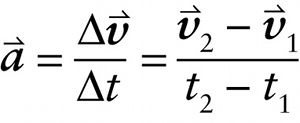Acceleration vector equals change in velocity vector divided by time interval (3-9)
Question 1 of 4
Question
Acceleration vector for the object over a very short time interval from time t1 to a later time t2
{"title":"acceleration vector for the object over a very short time interval from t sub 1 to a later time t sub 2","description":"Correct!","type":"correct","color":"#99CCFF","code":"[{\"shape\":\"rect\",\"coords\":\"1,38,24,72\"},{\"shape\":\"poly\",\"coords\":\"82,133\"}]"} {"title":"change in velocity of the object over the short time interval","description":"Wrong","type":"incorrect","color":"#ffcc00","code":"[{\"shape\":\"rect\",\"coords\":\"76,7,132,49\"},{\"shape\":\"rect\",\"coords\":\"118,11,119,13\"}]"} {"title":"elapsed time for the time interval","description":"Incorrect","type":"incorrect","color":"#333300","code":"[{\"shape\":\"rect\",\"coords\":\"80,71,117,100\"},{\"shape\":\"poly\",\"coords\":\"113,132\"}]"} {"title":"for both the velocity change and the elapsed time, subtract the earlier value from the later value","description":"Incorrect","type":"incorrect","color":"#000080","code":"[{\"shape\":\"rect\",\"coords\":\"260,5,297,53\"},{\"shape\":\"rect\",\"coords\":\"254,68,293,118\"}]"}Review
Equations 7-1 involve the accelerations of the skateboard and you, but we’re interested in the velocities of the skateboard and you after the push-off. To see how to get these, let’s go back to the definition of the acceleration vector in Section 3-5. This definition tells us that

